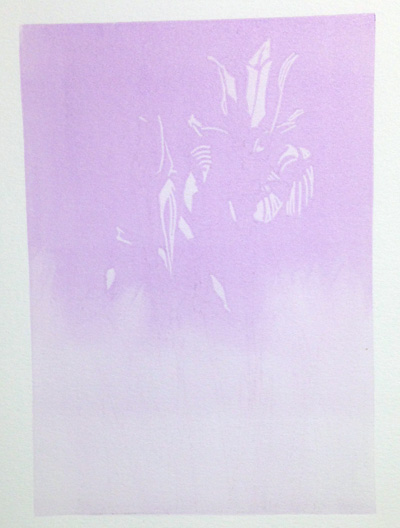But I digress...
Among the connections I made soon after I moved to Maine was the Biodiversity Research Institute (BRI). BRI has a number of research focii, but they began with the common loon.
In the autumn of 2019 BRI will be hosting the International Loon / Diver Symposium here in Maine (Portland). Ahead of that event, three other artists and I have been asked to create works to be featured on promotional materials. I'm more than a little bit behind schedule, since it took so long to find a place to settle and to get Presston up and running again, so before the iris prints were dry I jumped right in to my next linocut.
Loons were made for printmakers. Their lovely, graphic, black-and-white plumage begs for a relief print interpretation. Not that you can see any of it here in the first color pass.
 |
| New reduction linocut, blended roll, step 1 |
The tricky thing is that I am lacking in firsthand reference material. Sure, we have loons here, but I haven't been in Maine long enough to really spend time with them. I've been obliged to cobble together ideas and reference from a variety of sources, in much the same way I work as an illustrator.
To be honest, it's the thing I most dislike about illustration– being required frequently to render subjects I have never personally seen.
While I was working on the iris print I did take the time to do some pencil studies from photographic reference of loons. It helped to familiarize me with details, at least a little, and I'm having to squeeze every last drop out of my inadequate personal recollections and photography.
 |
| Two separate inks rolled up at the same time, transparent green at the top, transparent blue across the remainder of the block. Step 2 |
But that's enough whining. Once I took a deep breath and got started a lot (but not all) of that anxiety moved to the back seat. And by the second color pass I started to feel that familiar anticipation that makes printmaking the sweet agony that I return to again and again.
 |
| Step 2 |
I'm completely making up this color palette, imagining blues and greens and browns in the land and waterscape.
 |
| Step 3 |
I did make a rookie error right off the bat, though. 'Way back in Colorado I had decided that I should always start with an even, solid ink color– even if it's very pale– before laying down a blended roll. I failed to do that with this print, because I just plain forgot, and as a result I have some uneven color and lap marks in the lower half of most of the sheets.
I think (I hope) that this will become less obvious with additional color passes. If not... well... there will need to be some creative problem-solving at some point. Which differs from my usual working method how?
Right. It doesn't.































